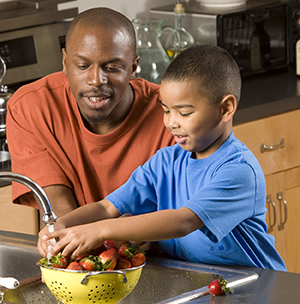When Your Child Has Constipation
Constipation is a common problem in children. Your child has constipation if their poop (stool) is hard and dry. This often leads to straining or having trouble pooping.
What causes constipation?
Constipation can be caused by:
-
Too little fiber in the diet
-
Too little liquid in the diet
-
Not enough exercise
-
Painful past poops (bowel movements). This can lead to your child holding in their poop.
-
Stress and anxiety issues. These can include changes in routine or problems at home or school.
-
Certain medicines
-
Too much cow's milk
-
Physical problems. These can include abnormalities of the colon or rectum.
-
Recent illness or surgery. This could be from dehydration and medicines.
What are common symptoms of constipation?
How is constipation diagnosed?
The healthcare provider examines your child. You’ll be asked about your child’s symptoms, diet, health, and daily routine. Your child may also need some tests or X-rays to rule out other problems.
How is constipation treated?

The healthcare provider can talk to you about treatment options. Your child may need to:
-
Eat more fiber and drink more liquids. Fiber is found in most whole grains, fruits, and vegetables. It adds bulk and absorbs water to soften poop. This helps poop pass through the colon more easily. Drinking water and moderate amounts of certain fruit juices, such as prune or apple juice, can also help soften poop.
-
Get more exercise. Exercise can help the colon work better and ease constipation.
-
Take stool softeners. The healthcare provider may suggest stool softeners to soften your child's poop. Your child should take them until having a bowel movement becomes more regular and the diet is adjusted. Discuss with your child's healthcare provider exactly which medicines to give you child and for how long.
-
Do bowel retraining. The healthcare provider may tell you to have your child sit on the toilet for 5 to 10 minutes at a time, several times a day. The best time to do this is after a meal. This helps the child relearn the feeling of needing to poop. Your child may be taught good sitting position on the toilet to help relax the muscles and avoid straining. This may be sitting on the toilet with support under the feet so the knees are above the level of the hips.
When to call the healthcare provider
Call the healthcare provider if your child:
-
Is vomiting repeatedly or has green or bloody vomit
-
Is constipated for more than 2 weeks
-
Has blood mixed in their poop or has very dark or tarry poop
-
Often has poop stains in their underpants
-
Cries or complains about belly pain not relieved by farting (passing gas)
-
Has trouble peeing in addition to trouble pooping
-
Belly pain gets worse
© 2000-2024 The StayWell Company, LLC. All rights reserved. This information is not intended as a substitute for professional medical care. Always follow your healthcare professional's instructions.